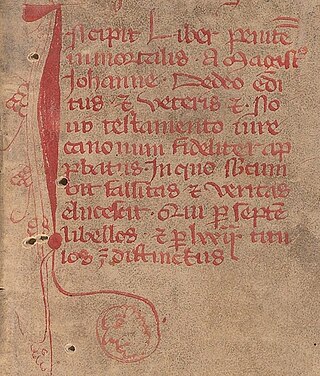Jus commune or ius commune is Latin for "common law" in certain jurisdictions. It is often used by civil law jurists to refer to those aspects of the civil law system's invariant legal principles, sometimes called "the law of the land" in English law. While the ius commune was a secure point of reference in continental European legal systems, in England it was not a point of reference at all. The phrase "the common law of the civil law systems" means those underlying laws that create a distinct legal system and are common to all its elements.

Irnerius, sometimes referred to as lucerna juris, was an Italian jurist, and founder of the School of Glossators and thus of the tradition of medieval Roman Law.

The Decretum Gratiani, also known as the Concordia discordantium canonum or Concordantia discordantium canonum or simply as the Decretum, is a collection of canon law compiled and written in the 12th century as a legal textbook by the jurist known as Gratian. It forms the first part of the collection of six legal texts, which together became known as the Corpus Juris Canonici. It was used as the main source of law by canonists of the Roman Catholic Church until the Decretals, promulgated by Pope Gregory IX in 1234, obtained legal force, after which it was the cornerstone of the Corpus Juris Canonici, in force until 1917.

The Apostolic Canons, also called Apostolic canons, Ecclesiastical Canons of the Same Holy Apostles, or Canons of the Holy Apostles, is a 4th-century Syrian Christian text. It is an Ancient Church Order, a collection of ancient ecclesiastical canons concerning the government and discipline of the Early Christian Church, allegedly written by the Apostles. This text is an appendix to the eighth book of the Apostolic Constitutions. Like the other Ancient Church Orders, the Apostolic Canons uses a pseudepigraphic form.

Burchard of Worms was the bishop of the Imperial City of Worms, in the Holy Roman Empire. He was the author of a canon law collection of twenty books known as the Decretum, Decretum Burchardi, or Decretorum libri viginti.
Astesanus of Asti was an important Franciscan canon lawyer and theologian, from Asti in Piedmont. His major work is Summa de casibus conscientiae, a confessional work, in manuscript from around 1317 and comprising eight volumes and three indices. Its writing is said to have been at the prompting of Cardinal Giovanni Gaetano Orsini.

Huguccio was an Italian canon lawyer.
The canon law of the Catholic Church is "how the Church organizes and governs herself". It is the system of laws and ecclesiastical legal principles made and enforced by the hierarchical authorities of the Catholic Church to regulate its external organization and government and to order and direct the activities of Catholics toward the mission of the Church. It was the first modern Western legal system and is the oldest continuously functioning legal system in the West, while the unique traditions of Eastern Catholic canon law govern the 23 Eastern Catholic particular churches sui iuris.
Gerard la Pucelle was a peripatetic Anglo-French scholar of canon law, clerk, and Bishop of Coventry.
Henry of Segusio, usually called Hostiensis, was an Italian canonist of the thirteenth century, born at Susa (Segusio), in the ancient Diocese of Turin. He died at Lyon.
In the history of canon law, a decretist was a student and interpreter of the Decretum Gratiani. Like Gratian, the decretists sought to provide "a harmony of discordant canons", and they worked towards this through glosses (glossae) and summaries (summae) on Gratian. They are contrasted with the decretalists, whose work primarily focused on papal decretals.

Stephen of Tournai,, was a Canon regular of Sainte-Geneviève (Paris), and Roman Catholic canonist who became bishop of Tournai in 1192.
Guido de Baysio was an Italian canonist.
Bartholomew of Brescia was an Italian canonist.
Simon of Bisignano was a teacher of canon law in Bologna in the 1170s. He composed a Summa on the Decretum Gratiani between March 1177 and March 1179. Like Paucapalea, he, too, might have been a student of Gratian himself.
Honorius of Kent was a medieval English Archdeacon of Richmond and canon lawyer.
Johannes Teutonicus Zemeke, also Joannes Simeca Teutonicus and John Zimeke, was a Decretist glossator, best known for his glosses on Gratian's Decretum in collaboration with Bartholomew of Brescia.
The Catholic Church utilizes the oldest continuously functioning legal system in the West, much later than Roman law but predating the evolution of modern European civil law traditions. The history of Latin canon law can be divided into four periods: the jus antiquum, the jus novum, the jus novissimum and the Code of Canon Law. In relation to the Code, history can be divided into the jus vetus and the jus novum. Eastern canon law developed separately.

Johannes de Deo was a Portuguese priest, judge and scholar of canon law who taught for over twenty years at the University of Bologna. He was a prolific writer.

The Quinque compilationes antiquæ is a set of five collections of twelfth and thirteenth century decretals totalling between 1,971 and 2,139 chapters.








